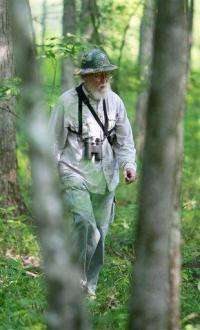Watchers track butterflies for environment signs

(AP) -- The rusty van creaks to a halt and two men jump out, binoculars in hand, heads pivoting. Quickly, questioningly, they call out evocative names: Is that a Pearl Crescent? A Carolina Satyr? A Sleepy Orange? A Swarthy Skipper?
It's butterfly counting time at a central Georgia wildlife refuge. That means a sweaty but fun outing for these two men, one a retired entomologist, the other the abbot of a Roman Catholic monastery. But it has a serious side: Some researchers worry butterfly populations may be in decline, possibly signaling a worsening environment.
The flying insects are often viewed as canaries in a coal mine because they are sensitive to changes in their habitats.
"When you see the absence of butterflies, you know something is wrong," says Jerry Payne, the entomologist on the recent counting expedition to Piedmont National Wildlife Refuge, about 70 miles south of Atlanta. Payne has tracked butterfly habitats for years.
"Unfortunately, we have met the enemy - and he is us," Payne says. "Man is the biggest reason for declining butterfly populations. We're taking away their land."
Butterflies play a key environmental role as a pollinator, fertilizing wild and cultivated plants by carrying pollen from one flower to another. In human eyes, butterflies are also a powerful symbol because of their transformation from caterpillar to graceful flight. That makes them a good standard-bearer for raising public awareness about habitat decline and species preservation, says Jaret Daniels of the Butterfly Conservation Initiative.
"They are that very visible, charismatic organism that can really rally the troops behind the importance of insects overall," Daniels says.
Roughly two dozen of the nation's hundreds of butterfly species are listed as endangered or threatened. The initiative is setting up workshops this year to train zoos, museums and others in butterfly conservation.
Some enthusiasts aren't sounding the alarm yet. Jeffrey Glassberg, president of the North American Butterfly Association, cautions that only a handful of species are in danger.
"You have to look at the big picture here," says Glassberg, a retired molecular geneticist who wrote the authoritative field guide, "Butterflies of North America." "There is still plenty of habitat."
But other researchers say there are clear signs that butterfly populations are under increasing threat, due either to climate change or human sprawl. A 2006 report by the National Academy of Sciences found evidence that some butterfly species key to pollination are on the decline.
"If you look at the numbers overall, they are declining slowly," says Daniels, an assistant entomology professor at the University of Florida in Gainesville. "There's no overriding trend of alarm, but within individual pockets there is."
To get a better idea of what's happening, various state and federal agencies with environmental missions team up annually with butterfly groups to plan hundreds of counts - including a handful of new sites that sprout up each year.
The counts aren't exactly scientific, as they largely depend on the talents and know-how of the volunteers. And it depends on how many enthusiasts show up to scout a park. But they help give researchers an idea of the diversity and relative numbers of butterflies in a given area.
They also help bring together enthusiasts like Payne and Francis Michael Stiteler, the abbot, who have been counting butterflies for years.
Stiteler started out following dragonflies, but turned to butterflies soon after arriving at the Monastery of the Holy Spirit in Conyers, Ga., in the 1970s.
He says he was "like a kid in a candy shop" roaming the monastery's 2,000 acres with binoculars and a camera to log the area's butterfly tenants. It's become a handy way to relieve the stress that comes with running the 40-monk Trappist monastery which, like other nonprofits, is facing financial woes amid the recession.
Payne has long been a bug buff - obsessed with insects since he was a hard-luck teen who couldn't get many dates. Compared to dating, he says now, "Insects were much cheaper to work with."
The two "butterflyers" were among about a dozen who descended on the Georgia refuge on a sweltering morning in late June, bringing the two most important elements of the hunt: Sharp eyes and keen peripheral vision.
"I get rid of all the other stuff," says Payne, "and I just see the butterfly."
The refuge's gravel roads were empty as they roamed in Payne's van, but sometimes it felt like they were in an invisible traffic jam: Every few feet, Payne slammed on the brakes to catch some real or imagined flicker of movement outside the dusty windows.
The two men eventually made their way to a grassy field, where they were overjoyed to find the Holy Grail of butterflying: A buttonbush, a magnet for the insects. The duo headed straight for it, plunging into chest-high grass with no regard for ticks or snakes.
"Zarucco Duskywing! Horace's Duskywing! Byssus Skipper!" yells Stiteler, excited to cross three more species off the list.
There are many keys to a good butterfly count. Fortunately for these two, being quiet isn't one of them.
---
On the Net:
http://www.butterflyrecovery.org/
©2009 The Associated Press. All rights reserved. This material may not be published, broadcast, rewritten or redistributed.















